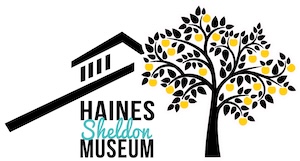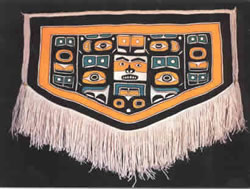
A Chilkat Blanket on display at the Sheldon Museum featuring a bear design woven by Jennie Thlunaut.
“Long ago there lived on the Skeena River, in British Columbia, a Tsimshian woman, a widow, of the village of Kitkatla, and her only daughter, ‘Hi-you-was clar’ (rain mother). It had been a season of extreme want. The deep snows of winter still covered the lowlands, and the spirit of hunger stalked abroad as a famished wolf. Day after day the girl sat, half dazed from want of food, staring vacantly at the intricately carved and painted picture that covered the rear partition of the house; for, although poor, they were of high caste, and their surroundings spoke of past greatness. The picture finally took possession of her, and setting up a rude frame, she forgot her suffering, and lost herself in the work of weaving an apron of like design. Later her hand was sought by the son of the chief and, in the exchange of presents, her handiwork was given to the father-in-law, who honored the occasion by a great feast, at which he wore the apron, and sacrificed many slaves in token of his appreciation of the gift….” The Chilkat Blanket by George Emmons
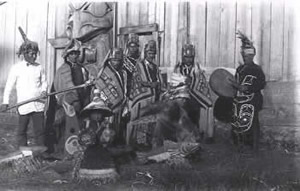
Tlingit men in regalia outside a Tlingit clan house.
The art of Chilkat Blanket weaving originated with the Tsimshian people (near Wrangell) but later spread to the Tlingits through trade and marriage. The Chilkat Tlingits (near Haines) who developed their own design style became the best and most copious weavers. These blankets, requiring a year of hard work to make, were highly sought by northwest coast Indian nobility long before the first explorers came to this region.
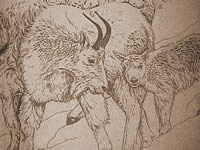
Mountain goat wool is used in tradional Chilkat Blankets.
Traditionally, only the wealthy could make or own a Chilkat Blanket. Both men and women played a role in the creation of the blankets and both considered it a great privilege to wear one. The men designed the pattern and made the pattern board and loom. They provided goat hides for wool. The women gathered cedar bark, prepared the yarn and wove the blanket.
The patterns were a highly stylized form of art often representing clan symbols and natural forms in an abstract geometric pattern. Animals were portrayed as if sliced down the center and laid out flat. The small circles are ball and socket joints. Eyes were often used as space fillers. The men designed the pattern and painted the abstract figures on a wooden “pattern board.” As the blanket was bilateral, only half the pattern was painted in life-size dimensions. The blanket pattern could be interpreted in a variety of ways, however only the man who designed the blanket knew the true legend.
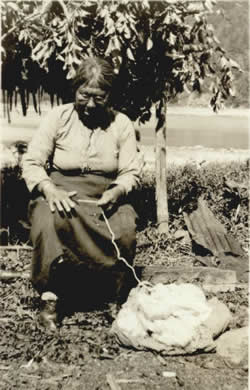
Mary Katcha Knuk Willard spinning mountain goat wool, circa 1920.
The woman would loosen the wool from the goat hide by wetting and rolling the hide then pushing the wool off with her thumb and fingers. She carded the wool by sitting with outstretched legs and the wool piled to one side. She drew the wool in the proper amount and fed it to her other hand. The wool was rolled between her palm and thigh to make a loose thread then rolled again to tighten. Two strands were rolled together to form the woof. A strip of cedar bark was rolled with the strands to make the warp yarn.
Traditional dyes for the woof yarn were yellow, derived from lichen called wolf moss; dark brown, produced by boiling wool in urine and hemlock bark; and a greenish-blue made by boiling wool in copper and urine. By the 1890s, commercial dyes and yarns were often used. The warp was never dyed.
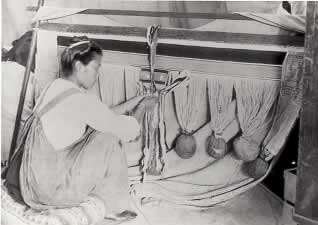
Mrs. John Benson weaving a Chilkat Blanket on a warp-weight loom, 1900s.
The blanket was woven on a “warp weight” or “single bar” loom, a simple loom consisting of two standing poles and a cross bar. The warp threads, suspended from a strip of moose hide, were hung from the cross bar. The long ends of the thread were tied into bundles, sometimes weighted with stones, to give tension to the working portion of the yarn. The weaver usually sat or kneeled in front of the loom while weaving. The blankets were woven entirely with the fingers. No other device was used. The finger-weaving was called twining. Two or more wefts were twisted around a single warp of yarn. When the blanket was completed, the fringe was filled out by adding extra lengths of warp yarn and braided borders were added.

Master Weaver Jennie Thlunaut’s last Chilkat Blanket modeled by her daughter Agnes Bellinger,copyright1985, Marilyn Holmes.
The Chilkat dance apron was one of the earliest products of the loom. Also made were ceremonial blankets, tunics, leggings and small pouches and purses. The blankets were used as ceremonial robes worn on special occasions such as a potlatch where they might be presented to honored guests; in dancing; surrounding a body while it lay in state; or occassionally hung on the outside of a grave house as a token of esteem.
The Chilkat Blanket held a key position in the Tlingit economy. It was widely known and highly valued even during the days of its maximum production. In trade, it was rivaled only by caribou hides and copper until guns were brought into the country. In the mid 1800s their value was about $30 – a large sum at that time. The blanket was a prized possession of anyone wealthy enough to own one.
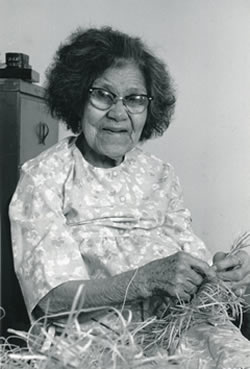
Jennie Thlunaut holding cedar bark strands for weaving.
During this century, the art of making the blanket has been in danger of dying out. In 1907, George Emmons reported 15 remaining weavers. Taught by her mother in the late 1890s, Master Weaver Jennie Thlunaut of Klukwan was the last of the traditional weavers. She made over 33 blankets and 6 tunics during her 96-year life span. In 1984, she conducted a two-week workshop in Haines to pass on the art of blanket weaving. Throughout the 1990s and to the present (2012), a few serious weavers have continued the tradition.
Cynthia Jones 1987
